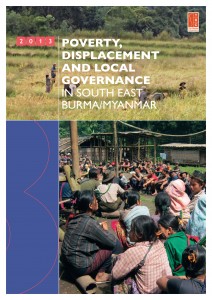Poverty, Displacement and Local Governance in South East Burma/Myanmar
By The Border Consortium • November 1, 2013 As the pace of reform has slowed in Burma/Myanmar during 2013, the potential for an inclusive political dialogue process to address the causes of conflict has increased. The sustainability of national reconciliation will require sensitivity to the concerns and aspirations of ethnic nationality communities in relation to identity, security and justice. This village-level survey describes the challenge of addressing chronic poverty, protracted displacement and weak governance at the community level in South East Myanmar as part of the conflict transformation process.
As the pace of reform has slowed in Burma/Myanmar during 2013, the potential for an inclusive political dialogue process to address the causes of conflict has increased. The sustainability of national reconciliation will require sensitivity to the concerns and aspirations of ethnic nationality communities in relation to identity, security and justice. This village-level survey describes the challenge of addressing chronic poverty, protracted displacement and weak governance at the community level in South East Myanmar as part of the conflict transformation process.
The Border Consortium (TBC) collaborated with eleven civil society organisations to design and conduct this assessment in 209 villages spread across 22 townships, 4 states and 2 regions. As the government’s village lists provide an incomplete sampling frame in contested areas, field staffs were advised to select one significant village per village tract. Almost half of the villages surveyed are administered to some degree by non-state armed groups and only 6% have been included in similar processes recently facilitated by UN agencies or other non-government organisations.
Decades of military rule, conflict and abuse have left rural communities impoverished, lacking basic infrastructure, struggling to cope with shocks to livelihoods and with limited access to social services. The vast majority of villagers are subsistence farmers with insufficient access to agricultural land to meet the threshold for self-reliance. While the ceasefire agreements have enabled greater access for farmers to fields and markets, the accompanying influx of mining, logging and commercial agriculture companies has exacerbated land grabbing and inequalities. Similarly, while accesses to health and education services are priority needs, there are concerns that the expansion of government services into ethnic areas could be a new form of assimilation and control.
As this year’s survey focused on village profiles across less townships than previously covered, it has not been possible to update last year’s estimate of 400,000 internally displaced persons in rural areas of South East Myanmar. However, new displacement is increasingly caused by natural disasters, such as the floods in central Karen State which displaced over 33,000 people in July, and abuses associated with resource extraction rather than armed conflict.
အစီရင္ခံစာ အႏွစ္ခ်ဳပ္ ျမန္မာဘာသာကို ဤေနရာတြင္ ေဒါင္းလုပ္ရယူႏိုင္ပါသည္။
Tags: Armed Conflict, Burmese, Ceasefire Agreement, Development, Displacement, Internally Displaced People, The Border ConsortiumThis post is in: Displacement, Spotlight
Related PostsBurma Army Displays Blatant Disregard for 21st Century Panglong Peace Process
On Union Day, Reappraisal of the Peace Process is Needed
ရွမ္းျပည္တိုိးတက္ေရးပါတီ၊ ရွမ္းျပည္တပ္မေတာ္ SSPP/SSA ထုတ္ျပန္ေၾကညာခ်က္
Time for the Government to Accept the Reality of Human Rights Problems, Take Effective Measures and Move Forward
Kachin Region: War Torn Displaced Village Profiles









 All posts
All posts